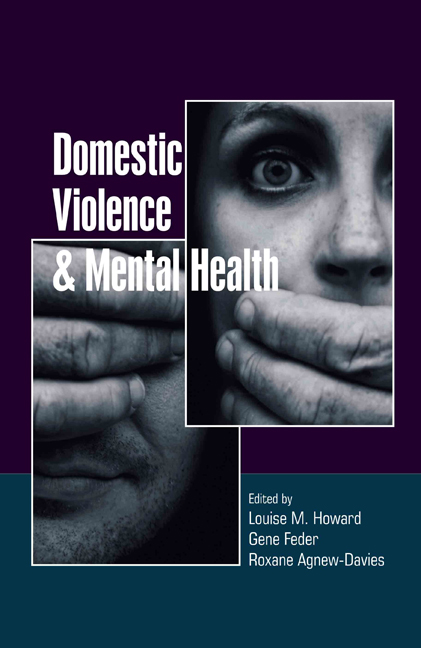Book contents
- Frontmatter
- Contents
- List of tables, boxes and figures
- List of contributors
- 1 Prevalence and physical health impact of domestic violence
- 2 Domestic violence and mental health
- 3 Identifying domestic violence experienced by mental health service users
- 4 Responding to disclosures of domestic violence
- 5 Interventions for mental health service users who experience domestic violence
- 6 Medico-legal issues
- Appendix 1 CAADA Risk Identification Checklist (RIC) and Quick Start Guidance for Domestic Abuse, Stalking and ‘Honour’-Based Violence
- Appendix 2 Domestic violence resources and directory of services
- Index
6 - Medico-legal issues
- Frontmatter
- Contents
- List of tables, boxes and figures
- List of contributors
- 1 Prevalence and physical health impact of domestic violence
- 2 Domestic violence and mental health
- 3 Identifying domestic violence experienced by mental health service users
- 4 Responding to disclosures of domestic violence
- 5 Interventions for mental health service users who experience domestic violence
- 6 Medico-legal issues
- Appendix 1 CAADA Risk Identification Checklist (RIC) and Quick Start Guidance for Domestic Abuse, Stalking and ‘Honour’-Based Violence
- Appendix 2 Domestic violence resources and directory of services
- Index
Summary
There are many areas of overlap between psychiatry and the law in the field of domestic violence. Mental health professionals need to be aware of their statutory and professional responsibilities, and criminal and civil court processes, given the possibility that they may be called to give evidence.
This chapter outlines key elements of this medico-legal interface; it focuses on the law as it currently stands in England and Wales, although many of the principles outlined are similar to those in other jurisdictions.
Safeguarding vulnerable adults
Safeguarding is about the well-being of adults who may have difficulty in protecting themselves from harm and abuse and in promoting their own interests. All persons have the right to live their lives free from violence and abuse. Safeguarding Adults (Association of Directors of Social Services, 2005) recognises the changing context from providing protection to promoting active citizenship. It replaces a narrower focus on the protection of ‘vulnerable’ adults and now encompasses all work which enables an adult ‘who is or may be eligible for community care services’ (Lord Chancellor's Department, 1997) to retain independence, well-being and choice, and to access their right to live free from abuse and neglect.
The overlap between safeguarding adults and domestic violence is significant, not least because domestic violence in itself can have a significant impact on mental health, as discussed in Chapter 2. This in turn may result in the victim becoming a vulnerable adult. There is also evidence that domestic violence is perpetrated disproportionately against vulnerable groups. Women who use mental health services are much more likely to have experienced domestic violence than women in the general population, and many older women also experience domestic violence (O'Keefe et al, health services in the UK were not clear about referral pathways for those experiencing domestic violence, and expressed mixed views on the value of vulnerable adult procedures (Trevillion et al, 2012). 2007). Women with disabilities are also particularly vulnerable to abuse (Brownridge, 2006). Safeguarding arrangements are therefore not only often applicable, but highly relevant to these vulnerable populations. It is of note that a recent study found that professionals working within mental health services in the UK were not clear about referral pathways for those experiencing domestic violence, and expressed mixed views on the value of vulnerable adult procedures (Trevillion et al, 2012).
- Type
- Chapter
- Information
- Domestic Violence and Mental Health , pp. 78 - 97Publisher: Royal College of PsychiatristsFirst published in: 2017

